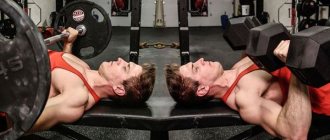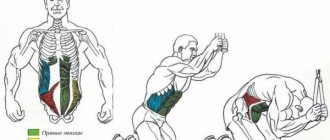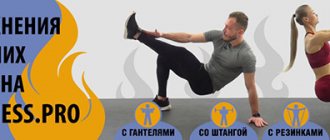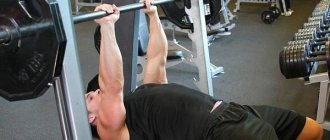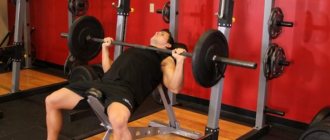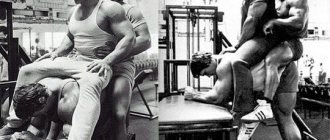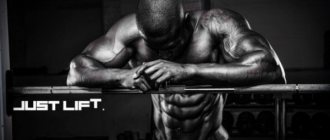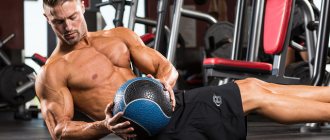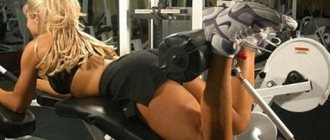Author: Timko Ilya - the ruler of the entire site and fitness trainer | more details >> Rod. 1984 Trained since 1999 Trained since 2007. Author and creator of the site tvoytrener.com. CCM in powerlifting. Champion of Russia and South Russia according to AWPC. Champion of the Krasnodar region according to IPF. 1st category in weightlifting. 2-time winner of the Krasnodar Territory championship in t/a. Author of more than 700 articles on fitness and amateur athletics. Author and co-author of 5 books.
Place in the author rating:
out of competition
(become an author)
Date:
2012-05-29
Views:
2,538,999
Rating:
4.9
| All articles by the author >> | Medals articles >> |
Articles are loading...
| Article medals: | article in TOP 10 | more than 1 million views |
Why medals are given to articles:
| Bronze medal: | |
| 1. The article is in the TOP 100 2. The article has more than 3. The article has more than 100 | |
| Silver medal: | |
| 1. The article is in the TOP 50 2. The article has more than 3. The article has more than 500 | |
| Gold medal: | |
| 1. The article is in the TOP 10 2. The article has more than 1 3. The article has more than 1,000 | |
Main muscles - rectus abdominis Additional - iliopsoas Difficulty - medium
Description of the exercise
Incline crunches are a basic abdominal exercise. It allows for many variations, varying in their impact and severity. This exercise is suitable both for the beginning of any workout (as a warm-up) and for the end.
Main features
1. The higher the inclination of the bench, the harder it is to do this exercise (all other things being equal).
2. Your task is to twist as much as possible (hunch your back) so that your abs work. If you rise with a straight back, it will not be the abs that will work, but the iliopsoas muscle.
3. You can either lower yourself completely onto the bench (while stretching your abs) or not lower yourself all the way. In the second case, the amplitude will be smaller. However, the abs will pound faster and harder.
4. You can use a barbell disc as a weight. You can place it either on your chest (easier option) or behind your head (more complicated option).
5. If you want the iliopsoas muscle to be disabled and only the abs to work, then do not lift your lower back off the bench at all. Just twist your back in the thoracic region. Although I don't see anything wrong with using extraneous muscles in this exercise.
6. If you still find it difficult to do this exercise, then cross your arms over your chest. Or grab the edges of the bench with your hands. It's easier.
Raising the torso on an incline bench
1) Lower and rise to the point that the abdominal muscles do not relax for a second and are constantly tense from the first to the last repetition;
2) When lowering, round your back so you relieve tension from the lower back;
3) When lifting your torso, you should not twist yourself completely; a clear example of incorrect execution is shown in Figure 2. The elbows should not reach the knees by about 10 cm, this allows you to always keep your abs tense.
4) When lifting, twisting even more tightly, tighten your abdominal muscles, or at the highest point of the lift, slightly straighten your back with your chin up (choose the option that will contract your abs the most);
5) Do not hold your breath, breathe deeply and correctly, inhale when relaxing, exhale when exerting effort.
6) The greater the inclination of the bench, the more difficult it is to perform the exercise, watch the technique, do not allow the body to rise through a jerk or push, only with the strength of the abdominal muscles.
7) Do not straighten your back when lifting, otherwise the lower back will be involved in the work, and the abs will lose the load, the back will be hunched as much as possible.
 There is no need to lower yourself onto the bench at the lowest point; leave your body suspended, not reaching the base 10-20 centimeters, in this case the abs will not relax and muscle failure will occur faster.
There is no need to lower yourself onto the bench at the lowest point; leave your body suspended, not reaching the base 10-20 centimeters, in this case the abs will not relax and muscle failure will occur faster.
9) During the exercise, hold your hands lightly near your temples and cross them over your chest; if you are a beginner and the exercises are difficult, hold on to the edges of the bench and help yourself slightly with your hands; as soon as your abs get stronger, helping with your hands is excluded.
Useful tips
- It is not recommended to lower the incline bench too steeply if this is your first time doing this exercise. Beginners should start with an incline of just 10 degrees. After gaining the necessary experience, you can move on to more complex techniques.
- There is no need to lower the bench below 45 degrees, as in this position the blood rushes strongly to the head, which is dangerous for athletes with weak blood vessels.
- If the exercise is too easy, you can cross your arms behind your head and do regular crunches. In this case, you do not need to help yourself with your hands - it is enough to lightly touch the back of your head with your fingers. In this type of twist, the neck is always kept straight and the chin looks straight.
- Beginners may have difficulty doing incline crunches. You can make this exercise easier by decreasing the tilt or stretching your arms along your body. The closer your hands are to your head, the greater the load on your abdominals.
- It is important to hold your breath while doing the crunch as this will increase muscle strength and help you complete the exercise. Exhalation is done immediately after reaching the highest point of the amplitude.
Description[edit | edit code]
Twisting with body raise on an inclined bench
Twisting with body lifting
As you exhale, slowly bend your upper torso. To complete this movement, bend your torso at the waist, tilting it towards your knees. Hold for a while and then slowly return to the starting position and repeat the exercise.
Initial position
- Lie on a bench inclined at an angle of 15-30 degrees, bend your knees and place your entire foot on the bench.
- Place your hands behind your head without clasping your fingers.
- Place your cervical spine in a neutral position.
- Activate your abdominal muscles.
Recommendations for implementation
- When performing crunches on an incline bench, do not use inertial force. Movements should be slow and controlled.
- The tailbone should be pressed tightly against the bench.
- Don't bend your neck too much or try to reach your chin to your chest. The head should maintain a neutral position in relation to the cervical spine.
- Do not help yourself with your hands when bending your torso. The movement should be accomplished by activating and isolating the abdominal muscles.
- Don't roll your shoulders in front. The chest should be straightened and the shoulder blades should be lowered.
- Exhale as you lift your torso, and inhale when returning to the starting position.
Main muscles involved during incline crunches
| Phase 1 | Phase 2 |
| Neck: sternocleidomastoid muscle Shoulder: serratus anterior, rhomboids, lower trapezius. | Torso: rectus abdominis, obliques. Neck: sternocleidomastoid muscle. |
Movement analysis[edit | edit code]
| Phase 1. Twisting | Phase 2. Lifting the body | |
| Major joints | Spine | Hip |
| Movements performed in the joints | Upward movement: flexion. Downward movement: extension. | Upward movement: flexion. Downward movement: extension. |
| Main muscles involved in movements | Rectus abdominis, obliques | Iliopsoas muscle, rectus femoris muscle |
Tips for athletes doing incline crunches
Do not tilt the bench at an excessively steep angle.
For beginners, an inclination of 10 degrees will be enough. As your abs become stronger, you can begin to increase the incline of the bench. The maximum angle should not exceed 45 degrees. If the angle is large, this will lead to a strong flow of blood into the head area, which can negatively affect your condition. If the movement has become too easy for you, then you can place your crossed arms behind your head, after which you perform classic twists. In this case, it is very important not to help lift the body with your hands, so as not to reduce the effectiveness of the exercise. You should also remember that the closer your hands are to your head, the more difficult it is to perform the movement. Watch your breathing as this will allow you to have a more intense session. Exhalation must be done only at the moment of reaching the highest position of the trajectory.
Hanging Knee Raise
Goal: working out the rectus abdominis muscles with increased impact on the lower muscles.
Technique:
- Hang on the bar as if you were going to do pull-ups.
- As you inhale, fold your legs together, bend them at the knees, and then pull this structure to the bottom of your chest.
- As you exhale, bring your legs to the starting position.
Exercise for beginners. Anyone who has done a serious abdominal workout at least once knows that the next day you feel like a weak-willed vegetable who cannot bend, straighten, or simply walk without pain in the abdominal area. In order not to discourage you from training, we recommend starting your abdominal workout with hanging knee raises.
This and the next exercise can be performed hanging on a bar, on a wall bars, on uneven bars, or on a machine that combines a horizontal bar with parallel bars and a backrest with armrests.
Hanging Leg Raise
Goal: working out the rectus abdominis muscles with increased impact on the lower abs. A more difficult version of the hanging knee raise.
Technique:
- Hang on the horizontal bar, close your legs together, then, while inhaling, lift your straight legs up, trying to raise them to a right angle.
- As you practice, raise your legs until they touch the bar.
- As you exhale, lower your legs down.
Once you've tried the hanging knee raise, you may find this exercise incredibly difficult. Indeed, it is so. If you are unable to complete more than 6 repetitions of this exercise with your legs raised above waist level, it is best to first increase the number of repetitions and sets of hanging knee raises, after which you can proceed to a more complex variation of this exercise.
Effective exercises
Girls can’t start working out in the gym or at home to build beautiful abs right away after giving birth.
It is important to wait 2-3 months to allow the body to regain its strength. After a caesarean section, the first abdominal exercise is permissible no earlier than six months later
All other categories of people can start training immediately, but after consulting a doctor.
Features of home training
If you train at home, then you should learn certain exercises to pump up your abs. We offer the most common options with photos and detailed descriptions of the equipment:
"Scissors"
The movement must be performed without straining the lower back, so it is important to keep it pressed tightly to the floor. You should lie down on a gymnastic mat, stretch your arms along your body, lift your straight legs off the floor and hold them at an angle of 30-45 degrees.
Then make swings overlapping each other, as if cutting with scissors. Perform for 1-3 minutes.
Plank. A static exercise that allows you to work and strengthen all muscle groups. You need to take a lying position, then bend your arms and rest on your forearms. The entire body should be elongated in one line. Hold the position for 1 minute.
Leg raises (reverse crunches). The starting position is the same as in the scissors exercise, but the trajectory of movement is different. It is necessary to raise your legs so that the angle between your torso and hips is 90 degrees. When raising your legs, fix your lower back and back, perform the movement only using the strength of the abdominal wall muscles. We perform 2-3 sets of 20 repetitions.
Twisting on the floor. This is a classic abdominal exercise. You need to lie with your back on the floor, move your legs towards your butt, and put your hands behind your head. We lift our shoulders and upper body off the floor and stretch our chest toward our knees. You can pump up your abs in this way in a comprehensive workout.
You can also follow the table, which indicates how many times you need to pump your abs a day in order to pump up your abdominal muscles with just this exercise.
Wheel exercises. A roller is a simple and inexpensive sports equipment for home training. It is a wheel with handles on the sides. To use it to work the muscles of the abdominal wall, you need to kneel down, grab the handles of the roller with your hands and move forward as much as possible, then return back.
Fitball training. With the help of a gymnastic ball, you can pump up any muscle group, the abs are no exception. You can perform classic and reverse crunches, as well as a number of other exercises. Let's consider the standard option. You should sit on the ball and roll it so that it is under your lower back. Feet rest on the floor, arms folded on the chest. We lift our shoulders and stretch forward, then return to the starting position. The ball will help you work without straining your lower back.
Working out at a sports club
In the gym you can work out your abs using exercise machines. Such classes are suitable for more experienced athletes.
The ideal solution for pumping up your abs would be the following classes:
On the uneven bars. You can stand on straight arms or focus on your forearms. Let's consider the technique according to the first option. We stand on the uneven bars with straight arms, slightly tilting our head and chest forward. We raise our legs parallel to the bars, then lower them. We do 3 sets of 10-15 times.
On the wall bars. As an option - on the crossbar. You need to grab the horizontal bar with your hands, then pull your legs bent at the knees towards your stomach. This will work the rectus abdominal muscles. You can quickly pump up your lateral muscles if you alternately turn them to the right and then to the left when lifting. The exercise should be performed 3 sets of 15-20 repetitions.
On a Roman chair. To pump up your abs on an inclined board, you should sit on it and fix your legs with bolsters. Next, we place our hands behind our heads and lean back, keeping our back rounded. You should not lie down completely on the bench. We perform 3 sets of crunches of 20 repetitions.
We hope our recommendations will be useful to you during abdominal training. We sincerely wish you good luck and a great mood. If the article turned out to be useful and interesting, tell your friends about it through social networks. Thanks in advance, and see you again!
2+
(No ratings yet)
Exercise technique
1. Lower the top edge of the bench at an angle of 30-40° to the horizontal. Sit on it and rest your shins on the bolsters.
2. Cross your arms over your chest and lower yourself back - your back, shoulders and head lie on the bench.
3. Inhale and hold your breath. Tighten your abdominal muscles and begin twisting - first your shoulders and head come off the bench, then your back.
4. Raise your torso solely through the efforts of your abdominal muscles. As soon as a right angle is formed between your torso and hips, freeze for a second and, exhaling, tighten your abs even more. Smoothly lower yourself to half the amplitude.
5. Do not relax your abs or touch the bench with your shoulders or head until the end of the set.
6. In the starting position, the gaze is directed to the ceiling, and during movement - always slightly above the crossed arms.
Incline Bench Crunches - Muscles
Raising the torso on a vertical bench
Goal: working out the rectus abdominis muscles.
Technique:
- Lie down in the exercise machine, fixing your legs under special bolsters.
- As you inhale, lift your torso all the way, then, exhaling, lower yourself to the starting position.
This exercise is good for its incomplete amplitude, which allows you to perform the movement in the maximum working trajectory, allowing you to achieve maximum burning in the abdominal area. It looks like crunches on the floor, but it’s more convenient to do it on a machine because your legs are fixed.
Mistakes when doing incline crunches
Of course, mistakes are mainly made by novice athletes, and most often this relates to the position of the hands during the movement.
If you want to hold your hands behind your head, then they should be located in the ear area. If you clasp your fingers together and hold your farts behind your head, you may pull your neck muscles during the exercise. It is important to ensure that your chest is straightened while working.
If your back is rounded, your risk of back injury increases significantly. When the body moves up, many athletes help themselves with their legs. This cannot be done, because it significantly reduces the effectiveness of twisting. Remember, all movements should be performed only using the strength of the target muscles, in this case the abs. To make your work a little easier, try to direct your gaze forward.
Reverse crunches
Reverse crunches or incline leg raises. A universal exercise for working the lower section of the rectus abdominal muscle. It also has a beneficial effect on the lumbar region.
Exercise technique
You need to lie on an inclined bench, feet down. Hold the bench tightly with your hands and try not to slide down the bench. Keep your abdominal muscles tense. Raise your legs and bend your knees slightly. This is the starting position.
Trying to touch your knees to your chest, lift your legs, lifting your pelvis off the bench. Hold the position for 2 seconds and return to the starting position. Beginners can do this exercise on a straight bench. To make it more difficult, you can use leg weights.
